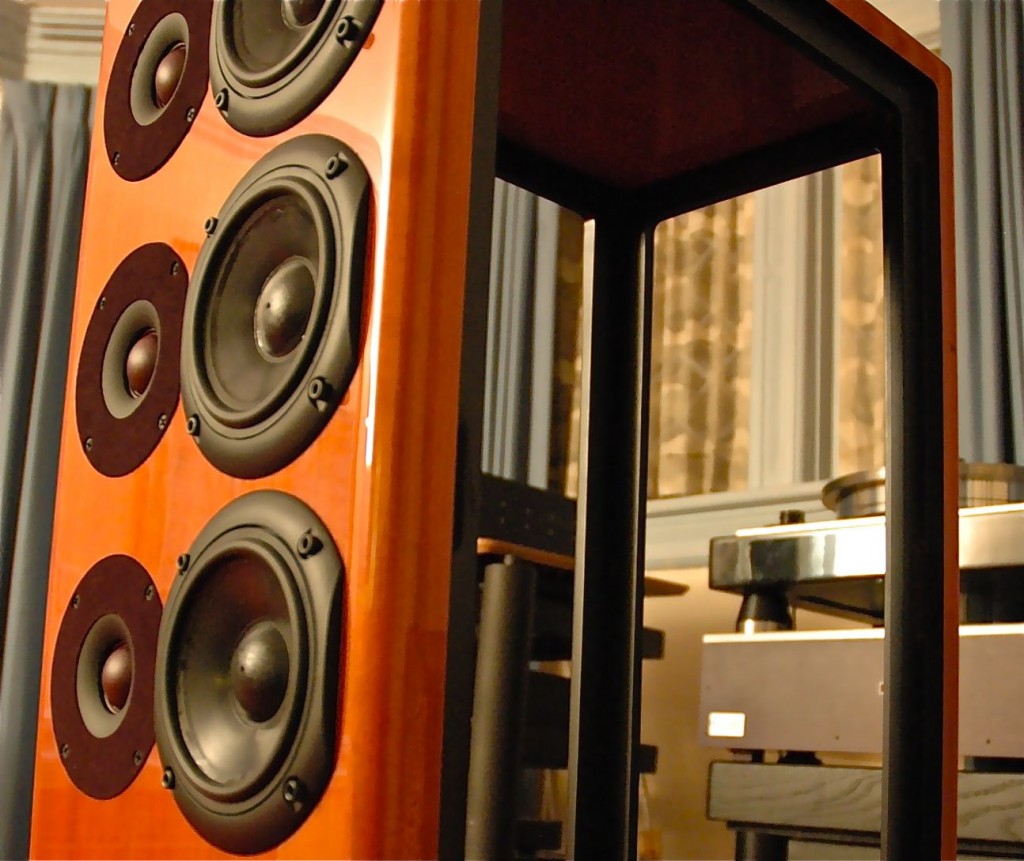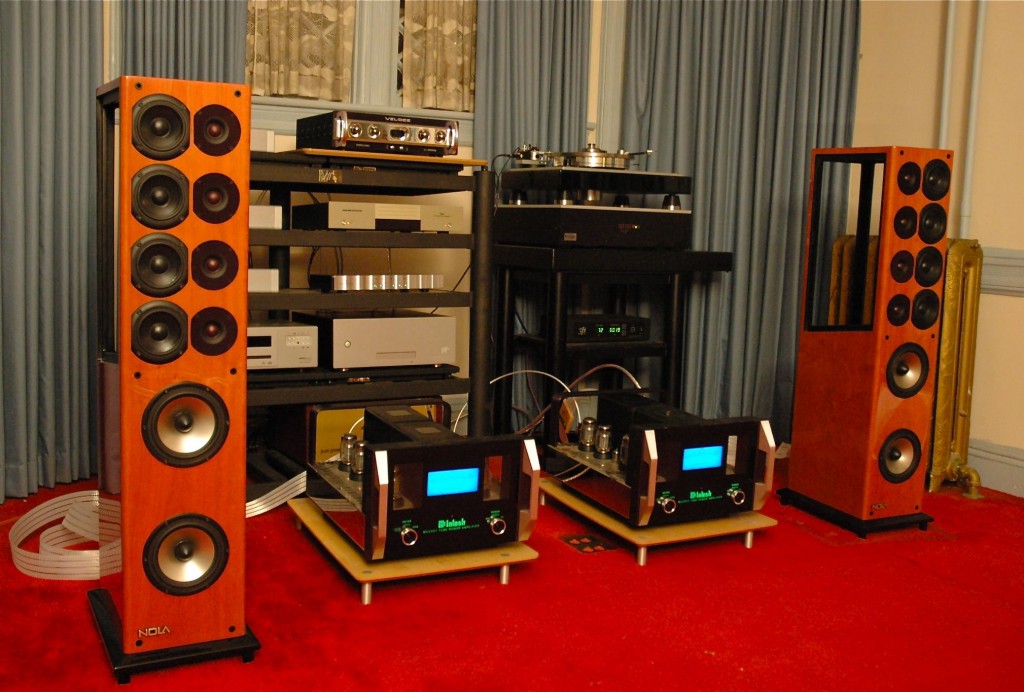
Review: NOLA KO Loudspeaker

From the very first moment, I found myself listening to the music, not to the speaker.
A unique experience.
And this happened with the KOs, Carl Marchisottos latest speaker system from Nola, which have come as close to being sonically invisible as any moderately sized and priced stereo pair ever in our experience. Maybe closer. They are, to these ears, a bit spooky, so close are they to capturing the actual feeling one gets hearing music per se as a listening experience.
The KOs never get in the way of the music- in no way do they call attention to themselves. They have none of the fingerprints that normal speaker systems have, a "seductivity" or attention-riveting sparkle to the sound.
Nothing sticks out. You wont hear the individual drivers, you wont hear the crossover points, you wont hear any sonic perturbations (or bulges) in the audible range. Let me put it this way: when you are normally listening to a speaker system, you know it. You hear the speakers themselves first, before you hear the traces of the music.
In our Listening Room 2, it sounds (and measures) as essentially flat from just above 32 Hertz out to the edges of audibility. It costs about $10,000 the pair, and it is not only handsome styled (and easy to drive), but conveniently sized so that a pair will fit in almost anywhere. The Knock-Outs are, dollar for dollar, one of the best buys (if not the) in contemporary speakers, and what makes them so good, in my opinion, is you find yourself listening to the music itself not to the "sound.” (Of course, it really helps if you know what the real thing sounds like.) It is that involving as an experience.
The speaker system is, top to bottom, completely coherent and without coloration. It goes up beyond what the human ear can hear, and this is does without bulges, dips, or those gross, or not-so-gross, distortions that normally reveal any audible character. Which means that it gets out of the way of the reproduced sound, and thus allows you, and your ears, the pleasure of listening to the music, rather than analyzing its lies about any set of individual frequencies.
And, this it does at a cost of (circa) $10 grand the pair. And that pair is quite, quite good looking, and populated with four silk dome tweeters, four dipolar cone mid-ranges, and two cast-frame metal cone woofers, each in its own enclosure -- per side. Marchisotto does not specify any crossover frequencies, claiming a new (and trademarked) technology, the Unison. I dont hear any crossovers and I really listened to detect any such, and I had to force myself to do this since I was absorbed into the speakers presentation of the recorded sound-field, and its three-dimensional imagery and ambience.

There is much more to tell about this system. We put the KOs to the test with the best associated gear we could find: the Veloce line stage (battery operated, tubed), the McIntosh 2301 super amps, the best Ed Meitner (EMM Labs) XSD1 CD player, the High Fidelity Cables CT-1 interconnects (which are genuine revelations in terms of speed and transparency), Nordost Vallaha and Odin cables, the Benz Micro LP-S moving coil cartridge, the VPI Classic 4 turntable (and JMW Memorial tone-arm). We could hear the differences among the components, but they did not subtract from the speaker systems musical magic.
Indeed, all the listening sessions turned into revelations of one kind or the other. For instance, Marchisotto brought over with him, the boxed set of 50 Mercury classic CDs (which he obtained through Amazon, and which I had not purchased since I had the original Wilma Cozart Fine CD dupes of the same recordings and saw no need to order another set, even though the price was tempting- $100 for 50 CDs). It turned out that the boxed set, a limited edition of no more than 7000 or so, did sound, to these ears, better than the authorized CDs, particularly in terms of aliveness and a kind of "presence.” Especially stunning on first listen was the Walton "Crown Imperial March" on a Federick Fennel/Eastman disc, with absolutely stunning dynamics, sensational (even scary) transient response -- the big drum hit half way through -- and a deeper low end, apparently with the organ pedal points. So great was the realism of this speaker on these transients that I found myself jumping -- and not just once, but each time the biggest crash came.
I began to understand all the better Cozart/Fines contention that, in some respects, the digital versions were more true to the original than the LPs, and this, I saw/heard was because no LP could reproduce the mighty transient waves as accurately. But then, to my way of thinking, the LPs had some things harmonically that eluded the digital transfers.
Not only was this a learning experience, but a superlative demonstration, along with others in the set, of why I had to purchase the 50 discs, even though I was left curious about the whys and wherefores of the improvements in the sound of the transfers. (Some informed speculation? The pressings of these CDs, which, by the way, were overseen by audio freaks in Asia. Superior plating, the likely answer.) What was clearly evident to me was that the KOs could, indeed, deliver a sonic knockout when one was required, and that as bonus for its merits of the musical truth in less extreme recordings.
At the price, at the performance level, at its proximity to the music experience itself, Id say this is something of a sonic triumph. I know this, I could easily live with the truths these speakers tell me. I dont feel as if I am missing anything.
~HP
Comment on HP’s review:
By Joey Weiss
After living with the KOs for some time now, it is safe to say that they are quite satisfying. I find my daily listening sessions lasting far longer than usual and tend to be inspiring. These speakers have an uncanny ability to push the listener deep into the music. Although I was nothing but impressed with digital playback, paired with an analog source (such as the VPI Classic 4) these speakers really came into their own.
The NOLA KOs have made themselves quite comfortable in Reference Room #2, the listening room which happens to be the most revealing one in house. The KOs are relatively easy to set up and sound great from a variety of seated locations (although nothing beats the sweet spot), making this speaker great for multi-person listening sessions. I have found that they sound their absolute best when driven by tube amplifiers, something the designer, Mr. Marchisotto highly recommends. Not hard to see why, considering NOLA uses the Western Electric 97A mono block amplifiers coupled with Audio Research components to test their speakers at their headquarters.
On a side note, I’ve always been fond of the approach Mr. Marchisotto employs when testing his speaker designs. Amongst his extensive tests, Mr. Marchisotto likes to listen to unaccompanied human voice played through the speakers to make sure it sounds right. Ever since Thomas Edison recited "Mary Had a Little Lamb" onto his wax cylinders, the quest to properly replicate the capturing and playback of the human voice has always been a substantial one. The sound of the human voice is so instinctual that we are able to perceive any imitation at a moments notice. If the voice actually sounds like a voice coming out of the speaker, then you have some ground to stand upon, and everything else will most likely follow suit. Perhaps this is why someone could claim that a speaker, such as the KO, sounds "natural" to the ear.
~JW